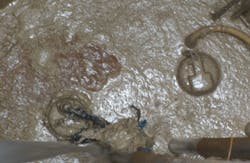Submersible pumps shred solids before passing the liquid
The problematic pumps controlled evacuation of the plant’s wet wells. These 10-hp, 4-inch non-clog, cast-iron units were installed in the main lift station that pumped from the factory’s wastewater pretreatment plant to the city’s force main sewer. The wet well of this treatment plant lift station catches the effluent from the entire operation, i.e., the process waste stream and sanitary sewer line.
At an USFDA certified meat processing plant, product quality and public safety are primary concerns, and plants adhere to strict federal guidelines. As you might expect, meat processing requires the conveyance of many process fluids and wastes. Operational success is contingent upon moving these liquids efficiently and continuously.
Two streams combined
At the meat processing plant, the process waste stream includes a mix of spices, meat juices and cleaning chemicals, while the sanitary sewer line handles restrooms and showers.
Interestingly enough, cold-cut meats are involved in three types of processing, listed below. The first two are accomplished at the plant under discussion.
- Whole cuts use a section of meat or poultry that has been cooked and flavored with spices or sugars, then sliced. These are typically the more expensive type of cold cuts. Examples are turkey breast and roast beef.
- Sectioned and formed cold cuts are restructured meat products. They are prepared from chunks or pieces of meat that are bonded together to form a single meat loaf. Examples would be chicken roll and cooked ham.
- Processed meats, which make up the bulk of cold cut offerings, are chopped, seasoned and formed into a symmetrical shape. An example would be bologna.
The sanitary sewer line, as might be expected, contains a heavy load of sanitary products, including wipes and personal hygiene products.
The solids content from this combined flow caused continual blockages, meaning the non-clog pumps had to be pulled at least once a week to be cleared, cleaned and reset. Weekly maintenance of the "non-clog" pumps was done by an outside contractor and involved use of a small crane, at a cost of $350 per visit. This amounted to more than $20,000 a year in extra maintenance expense.
Additional risk and cost were involved should the pumps not operate effectively. If the waste treatment plant could not discharge to the city, the plant would be forced to bypass the pretreatment plant and thereby face substantial fines from the city.
Time to act
Called in by the meat processor, Ken Weichhand, west Michigan manager for Kerr Pump and Supply, a Detroit, Mich.-based fluid-handling distributor, studied the system and media-handling requirements and proposed a solution whereby the existing pumping units were replaced with shredder pumps, i.e., pumps that "shred" solids before passing the liquid.
The pumps used for the project are already found in farm and food sump applications handling agricultural and animal waste. Detroit-based BJM Pumps’ SK series Shredder pumps leave solids slightly larger than if passed through a grinder pump. The shredding action is produced using a non-clog cutting impeller — with tungsten carbide vane tips referred to as "teeth" — against a high-chrome "scalloped" wear plate.
The cutting teeth shred solids against the pump-suction plate, continuously ripping them apart with a 360-degree shredding action. It works on many objects that would clog an ordinary pump. The hardened impeller and plate materials have maximum wear resistance for long service life. Other important life-cycle enhancing features of the SK Series Shredder Pumps include:
- 304SS motor housing provides superior abrasion resistance. It will not wear out like aluminum motor housings when pumping water with abrasive content.
- Robust pump construction — hardened cast iron stands up to rough handling and pumping gritty water unlike pumps with soft-resin impellers or plastic exterior components. Cast stainless steel is available for added corrosion protection.
- More motor protection — Winding protection and (NEMA) Class F motor insulation allows motor temperature to raise to 230 F, superior to pumps with Class A and B insulation. An automatic switch turns the pump motor off if the temperature or amperage draw rises too high. When the motor cools the switch will automatically reset and the pump will turn back on.
- Three-seal motor protection provided by double mechanical seals. The lower seal is made of silicon carbide/silicon carbide, while the upper is made of carbon/ceramic. An additional lip seal has been installed above the impeller, to help prevent abrasives from entering the seal chamber.
Kerr installed two BJM SK110C shredder pumps and rail systems in the problematic sump. Kerr saved the customer additional expense by using the existing control panel and upgrading the motor starters to handle the 15-hp motors.
Since their installation about 16 months ago, the BJM pumps have run without incident. Savings total more than $22,400 with an annual contribution to this plant’s bottom line of $20,000. Since the project’s completion, the meat processor has changed out additional pumps in its wastewater treatment plant with shredder pumps.
Mike Bjorkman is director of marketing and IT, BJM Pumps.
Kerr Pump and Supply was founded in Detroit, Mich., in 1905. Three years before the famous Ford Model T and the founding of General Motors, Kerr was providing highly engineered, cost effective, efficient and reliable equipment for Michigan’s industrial, commercial and municipal markets. Today, Kerr represents corporate America, Europe and Asia’s premier brands of fluid- and air-handling equipment.
BJM Pumps, Old Saybrook, Conn., has provided fluid-handling solutions for industrial and municipal services since 1983. Over its 30-year history, BJM Pumps has grown quickly by supplying world-class pumps and accessories, priced competitively, through its global network of stocking distributors.


